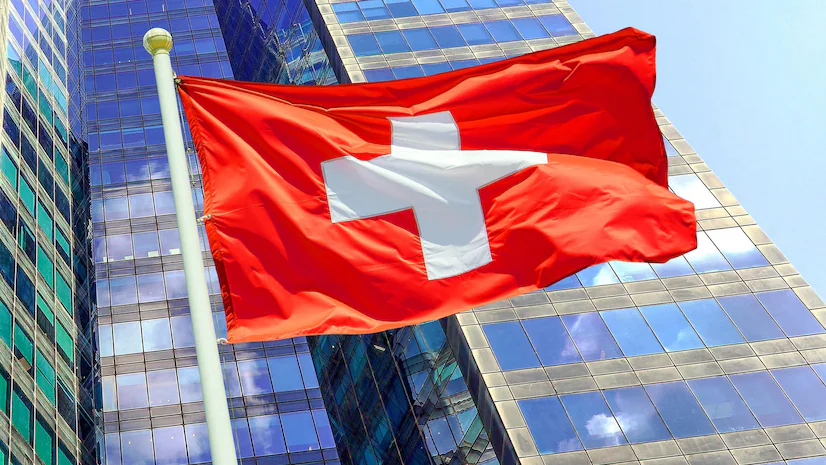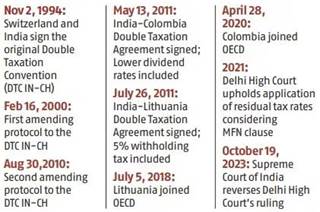- Courses
- GS Full Course 1 Year
- GS Full Course 2 Year
- GS Full Course 3 Year
- GS Full Course Till Selection
- Answer Alpha: Mains 2025 Mentorship
- MEP (Mains Enrichment Programme) Data, Facts
- Essay Target – 150+ Marks
- Online Program
- GS Recorded Course
- Polity
- Geography
- Economy
- Ancient, Medieval and Art & Culture AMAC
- Modern India, Post Independence & World History
- Environment
- Governance
- Science & Technology
- International Relations and Internal Security
- Disaster Management
- Ethics
- NCERT Current Affairs
- Indian Society and Social Issue
- NCERT- Science and Technology
- NCERT - Geography
- NCERT - Ancient History
- NCERT- World History
- NCERT Modern History
- CSAT
- 5 LAYERED ARJUNA Mentorship
- Public Administration Optional
- ABOUT US
- OUR TOPPERS
- TEST SERIES
- FREE STUDY MATERIAL
- VIDEOS
- CONTACT US
Switzerland Suspends MFN Clause in DTAA with India
Switzerland Suspends MFN Clause in DTAA with India
11-02-2025

On January 1, 2025, Switzerland suspended the Most-Favoured-Nation (MFN) clause in the Double Taxation Avoidance Agreement (DTAA) with India.
What is Double Taxation Avoidance Agreement (DTAA)
- A DTAA is a treaty between two countries designed to prevent double taxation of income.
- It ensures that the same income is not taxed both by the source country (where the income is earned) and the residence country (where the taxpayer lives or is based).
- India’s Engagement with DTAAs:
- India has signed DTAAs with over 90 countries, including major global economies like the USA, UK, UAE, Singapore, and Mauritius.
- India’s tax treaties have evolved over the years to balance the interests of foreign investors, multinational corporations, and the domestic economy.
What is MFN Clause in the DTAA: Key Points
- The Most-Favoured-Nation (MFN) clause in a DTAA which ensures if a country provides better tax benefits to a treaty partner then it should provide to any of its other "most favored" treaty partners.
- Example: If India offers a tax rate of 10% on dividends to France, Switzerland can also claim the same rate for its taxpayers, even if the original agreement offered a higher rate.
- Example: If India offers a tax rate of 10% on dividends to France, Switzerland can also claim the same rate for its taxpayers, even if the original agreement offered a higher rate.
- MFN Principle in the WTO:
- The MFN principle is also a core element of the World Trade Organization (WTO).
- It is codified in:
- Article I of the General Agreement on Tariffs and Trade (GATT).
- Article 2 of the General Agreement on Trade in Services (GATS).
- Article 4 of the Agreement on Trade-Related Aspects of Intellectual Property Rights (TRIPS).
- This principle ensures that trade advantages granted to one WTO member country must be extended to all WTO member countries.
India-Switzerland DTAA and the MFN Clause
- India and Switzerland signed the Double Taxation Avoidance Agreement (DTAA) in 1994.
- This agreement was later amended in 2010
- The MFN clause (Article 11) was included in the revised agreement of 2010.

MFN Clause in the 2010 Protocol:
- In the 2010 protocol between India and Switzerland, the MFN clause said that if India made a deal with any OECD country offering lower tax rates, those lower rates would also apply to the Swiss-India DTAA.
- In 2011, India signed a treaty with Lithuania and Colombia. But Both of these countries joined the OECD in 2018 and 2020 respectively. .
- Because of the MFN clause, Switzerland believed that the lower tax rates in the treaties with Lithuania and Colombia should also apply to the Swiss-India agreement, starting from the year each country joined the OECD. This meant:
- From 2018, the lower tax rates in the Lithuania-India treaty would apply to Switzerland.
- From 2020, the lower tax rates in the Colombia-India treaty would apply to Switzerland.
- As a result, Indian tax residents could claim refunds for Swiss withholding taxes from 2018 (for Lithuania) and 2020 (for Colombia), based on the lower tax rates.
What is Nestlé SA Judgment (2023):
- A significant ruling by the Supreme Court of India in 2023 clarified how the MFN clause in the India-Switzerland DTAA works.
- Supreme Court ruled that the MFN clause could not apply retroactively to countries that became OECD members after the protocol was signed.
- This means if India makes a deal with another country that lowers taxes, Switzerland doesn't automatically get those lower taxes if that other country joined the OECD after the India-Switzerland tax treaty was signed.
- For the tax benefits of other treaties to apply, the DTAA needs to be formally notified under Section 90 of the Income Tax Act, 1961.
Significance of the DTAA in Global Tax Governance
- DTAAs give clear rules for taxpayers, helping businesses and individuals avoid paying taxes twice and plan their finances better.
- These rules are important for businesses working in different countries.
- DTAAs stop tax evasion by closing gaps that would let people or companies avoid taxes using different tax laws.
- For example, India changed its DTAA with Mauritius to stop people from misusing it to move money around.
- DTAAs help businesses pay less tax by offering lower tax rates between countries.
- Companies can also get refunds for taxes paid in other countries, reducing costs for international trade.
- DTAAs lower the Tax Deducted at Source (TDS) on income like dividends, royalties, and interest from other countries.
- For instance, foreign investors getting dividends in India may pay a lower TDS rate under the India-Switzerland DTAA.
- DTAAs usually have a Mutual Agreement Procedure (MAP) to help solve problems of double taxation.
- For example, India and Japan use MAP to solve transfer pricing issues.
Challenges in DTAA Architecture
- Treaty Shopping happens when companies move their investments through countries that have good tax deals, even if they don’t have much actual business there. This can defeat the purpose of Double Tax Avoidance Agreements (DTAAs).
- For example, some investors used Mauritius to avoid paying taxes on capital gains under the India-Mauritius DTAA, even though their investments didn’t have much of a real presence in Mauritius.
- Countries may interpret DTAA provisions differently, leading to disputes and possible double taxation.
- The Nestlé SA case in 2023 is an example of how differing interpretations between India and Switzerland caused confusion regarding the MFN clause.
- DTAAs sometimes conflict with domestic laws, creating confusion for taxpayers on which provisions to follow.
- In India, the Income Tax Act may have provisions that don't align with certain DTAA terms, causing compliance challenges.
India-Switzerland Relations
|
|
Also Read |
|
| FREE NIOS Books | |



